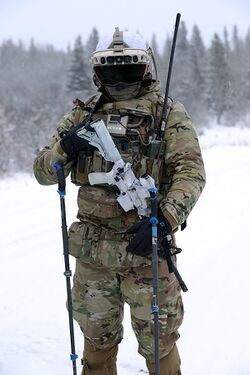Acrean Center for Aerospace Research: Difference between revisions
No edit summary |
No edit summary |
||
| Line 39: | Line 39: | ||
===NAVI=== | ===NAVI=== | ||
[[File: | [[File:MjolnirMk1.jpg|thumb|left|250px|An Acrean soldier equipped with MJÖLNIR in December 2021.]] | ||
In 2015, ARC began development of a satellite internet network called NAVI in cooperation with several private Acrean telecommunications and tech firms. The intention behind the project was, as stated, for two goals- the first was to allow global satellite internet access to public services and the military, while the second was envisioned as allowing Acrean firms to leverage the network to provide new services to consumers. The system would allow for relatively high-speed, high-bandwidth internet connectivity globally, especially in rough, rural, or wild terrain where there is poor or no internet access available. The system is capable of operating on individual devices in conjunction with ground transceivers, as well as being accessed by relatively compact terminals, with signals able to be received from antennae mounted nearly anywhere with open sky including on moving vehicles. While negotiations for its use as a commercial system are ongoing, with some beta testing ongoing with firms for its appeal to consumers, the system is considered to be highly desirable for emergency services and the military. Since the launch of the first satellites in 2018, the system has seen substantial use by Acrean emergency services and authorities operation in rough terrain such as wildlife rangers and search-and-rescue teams. NAVI has begun the process of being integrated into the Acrean military's | In 2015, ARC began development of a satellite internet network called NAVI in cooperation with several private Acrean telecommunications and tech firms. The intention behind the project was, as stated, for two goals- the first was to allow global satellite internet access to public services and the military, while the second was envisioned as allowing Acrean firms to leverage the network to provide new services to consumers. The system would allow for relatively high-speed, high-bandwidth internet connectivity globally, especially in rough, rural, or wild terrain where there is poor or no internet access available. The system is capable of operating on individual devices in conjunction with ground transceivers, as well as being accessed by relatively compact terminals, with signals able to be received from antennae mounted nearly anywhere with open sky including on moving vehicles. While negotiations for its use as a commercial system are ongoing, with some beta testing ongoing with firms for its appeal to consumers, the system is considered to be highly desirable for emergency services and the military. Since the launch of the first satellites in 2018, the system has seen substantial use by Acrean emergency services and authorities operation in rough terrain such as wildlife rangers and search-and-rescue teams. NAVI has begun the process of being integrated into the Acrean military's battlefield management system and the MJÖLNIR infantry integration system after successful tests with all three branches in 2020. | ||
[[Category:Acrea]] | [[Category:Acrea]] | ||
Revision as of 00:56, 15 April 2022
Akrienske Rymdforschungscentrum | |
 | |
| Abbreviation | ARC |
|---|---|
| Formation | 1949 |
| Headquarters | Trier, Steiermark, |
Official language | Nordic German French |
Administrator | Jos Vahlen |
| Köniz-Sterzing Space Centre | |
Budget | ₤25.4 billion |
The Acrean Center for Aerospace Research (ARC) is an agency of the Acrean government responsible for conducting space and aeronautical research, and maintaining the Acrean space programme. It is a successor to the Acrean Aeronautical Research Board created in 1921. Although originally conceived and operated as a purely civilian agency, extensive cooperation with the military has led to it having a substantial component of military personnel and researchers.
ARC's programmes included manned spaceflight, unmanned exploration missions, advanced aircraft research, unmanned aircraft testing, satellite launch and maintenance, spacecraft and launch vehicle engineering, and communications. Since 2010, key programmes for the agency have been the development of reusable launch vehicles of various payload capabilities, construction of a satellite internet network, and upgrades to Acrea's existing navigation and telecommunications satellite constellations including CGNS, the global satellite navigation system launched by Acrea in the late 1970s and early 1980s.
History
Mission
Activities and Programmes
CGNS
Since the late 1970s ARC has been responsible for the maintenance and upgrading of CGNS, the global satellite navigation system launched by Acrea in the late 1970s to provide accurate, encrypted positioning data for the Acrean military. The system was opened to civilian and foreign use in the late 1980s with reduced accuracy and the ability for the Acrean government to selectively deny access to or degrade the service, but is widely available to be used by any device which possesses a CGNS receiver without the need to transmit data to the satellite network. Although ARC participated in the construction and maintenance of the system since its inception, it shared responsibility alongside the Acrean Air Force until sole responsibility was given to ARC in 1998. Since then, ARC has devoted substantial effort and resources into continuously upgrading the network for both Acrean military and commercial use and achieving a reported accuracy of 1 cm for military receivers in 2020, with commercial receivers capable of 30cm in modern devices.
ESR Launch Vehicle Fleet
Since 2008, ARC has been extensively involved in the development of a new fleet of partially reusable heavy launch vehicles to support future projects by reducing the cost of launching satellites, spacecraft, and components into orbit. First announced in 2003, the project has resulted in the ESR line of launch vehicles which saw their first launch in 2009 and the first successful demonstrations of first-stage recovery in 2014. Regular operation of the rockets began in 2016 with the ESR I launch vehicle, with the larger ESR II capable of launching nearly three times the payload becoming operational in 2019.
The introduction and further development of the ESR programme is estimated to achieve its goal of drastically reducing the cost of launching payloads into orbit, and would allow ARC to both increase its efforts to construct new satellite constellations, orbital platforms, and the like, as well as offer to allow partnering space agencies and commercial firms to contract the use of their launch vehicles at reduced cost compared to their own payload delivery options.
NAVI
In 2015, ARC began development of a satellite internet network called NAVI in cooperation with several private Acrean telecommunications and tech firms. The intention behind the project was, as stated, for two goals- the first was to allow global satellite internet access to public services and the military, while the second was envisioned as allowing Acrean firms to leverage the network to provide new services to consumers. The system would allow for relatively high-speed, high-bandwidth internet connectivity globally, especially in rough, rural, or wild terrain where there is poor or no internet access available. The system is capable of operating on individual devices in conjunction with ground transceivers, as well as being accessed by relatively compact terminals, with signals able to be received from antennae mounted nearly anywhere with open sky including on moving vehicles. While negotiations for its use as a commercial system are ongoing, with some beta testing ongoing with firms for its appeal to consumers, the system is considered to be highly desirable for emergency services and the military. Since the launch of the first satellites in 2018, the system has seen substantial use by Acrean emergency services and authorities operation in rough terrain such as wildlife rangers and search-and-rescue teams. NAVI has begun the process of being integrated into the Acrean military's battlefield management system and the MJÖLNIR infantry integration system after successful tests with all three branches in 2020.


